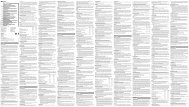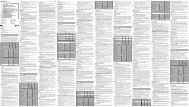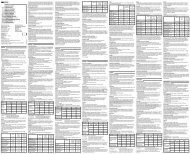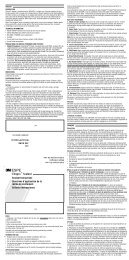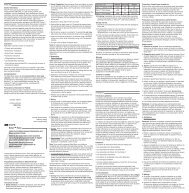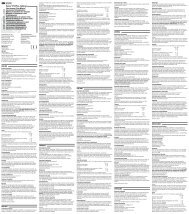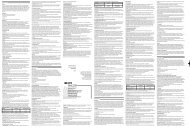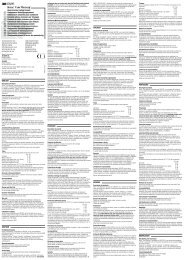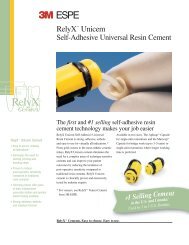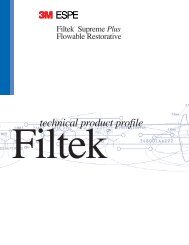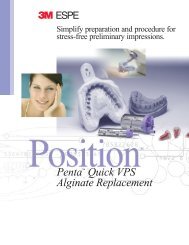RelyX⢠ARC Adhesive Resin Cement - Dale Dental
RelyX⢠ARC Adhesive Resin Cement - Dale Dental
RelyX⢠ARC Adhesive Resin Cement - Dale Dental
You also want an ePaper? Increase the reach of your titles
YUMPU automatically turns print PDFs into web optimized ePapers that Google loves.
of allergic response, minimize exposure to these materials. In particular, exposure to uncured resin<br />
should be avoided. Use of protective gloves and a no touch technique is recommended. If adhesive<br />
contacts skin, wash immediately with soap and water. Acrylates may penetrate commonly used<br />
gloves. If adhesive contacts glove, remove and discard glove, wash hands immediately with soap<br />
and water and then reglove. <strong>Adhesive</strong> may cause eye irritation upon contact. Avoid contact with<br />
eyes. If accidental contact occurs, flush immediately with large amounts of water. If irritation<br />
persists, consult a physician.<br />
31<br />
Sensitivity:<br />
Some patients may experience transitory postoperative sensitivity. The risk of sensitivity can be<br />
minimized by the following measures: Remove minimal amount of tooth structure. Use proper<br />
isolation. Use of a rubber dam is highly recommended. Use adequate pulp protection. Use a glass<br />
ionomer liner/base in areas of deep excavation. Place restorative material in increments, curing<br />
each increment separately. Adequately cure restorative according to instructions for shade and<br />
thickness of restorative and light exposure time. Adjust occlusion carefully. Check for hyperocclusion,<br />
particularly in lateral excursion contacts. Do not air dry tooth structure after etching. Do not<br />
overdry during the bonding procedure. Do not overetch.<br />
Etchant Syringe Assembly:<br />
1. Protective eyewear for patients and staff is recommended when using the delivery system.<br />
2. Prepare the delivery system: Remove cap from etching gel syringe and SAVE. Twist a blue<br />
disposable tip securely onto the syringe. Holding the tip away from the patient and any dental<br />
staff, express a small amount of etching gel onto a dispensing pad or a 2 × 2 gauze to assure<br />
that the delivery system in not clogged. If clogged, remove the dispensing tip and express a<br />
small amount of gel directly from the syringe. Remove any visible plug, if present, from the<br />
syringe opening. Replace dispensing tip and again express etching gel. If clog remains, discard<br />
dispensing tip and replace with a new one. Bend the dispensing tip to a desired angle. Place<br />
bend midway along tip. Do not bend dispensing tip at its hub as it may break free.<br />
3. Delivery system storage: Remove used dispensing tip and discard. Twist on storage cap. Storage<br />
of the delivery syringe with a used dispensing tip or without storage cap will allow<br />
drying of the etching gel and consequent clogging of the system. Replace storage cap with<br />
a new dispensing tip at next use.<br />
4. If desired, the etching gel may be extruded onto a dispensing pad and applied with a brush or<br />
other appropriate instrument.<br />
5. If a liquid etchant is desired, the etching gel may be dispensed into a dappen dish and stirred<br />
to increase its fluidity.<br />
6. Disinfection: Discard used dispensing tip. Replace syringe cap. Disinfect the capped syringe<br />
in the same manner as nonimmersible handpieces, air/water syringe and ultrasonic scalers<br />
following American <strong>Dental</strong> Association (ADA) and Centers for Disease Control (CDC) recommendations.<br />
(Council on <strong>Dental</strong> Materials, Instruments and Equipment and Council on<br />
<strong>Dental</strong> Therapeutics. Infection control recommendations for the dental office and the dental<br />
laboratory. JADA 116(2):241-248, 1988.)<br />
Instructions for Direct Light-Cure Restorations in Enamel and Dentin:<br />
1. Isolation: Rubber dam is the preferred method of isolation.<br />
2. Cavity preparation: Prepare cavity with minimal tooth reduction. Bevel cavosurface enamel<br />
margins.<br />
3. Etching: Apply 3M Scotchbond Etchant to enamel and dentin. Wait 15 seconds. Rinse for<br />
10 seconds. Blot excess water leaving tooth moist.<br />
4. <strong>Adhesive</strong>: Using a fully saturated brush tip for each coat, apply 2 consecutive coats of Single<br />
Bond adhesive to etched enamel and dentin. Dry gently for 2-5 seconds. Light-cure for 10<br />
seconds.<br />
5. Restorative placement, cure and finishing: Refer to manufacturer’s instructions for placement,<br />
cure and finishing of restorative materials.<br />
Instructions for Direct Light-Cure Restoration of Noncarious Cervical Lesions:<br />
To restore noncarious cervical lesions, clean the lesion and adjacent enamel with a plain pumice/<br />
water slurry. Do not use prophy pastes containing oils. Remove excess surface moisture by blotting.<br />
Leave dentin moist.



